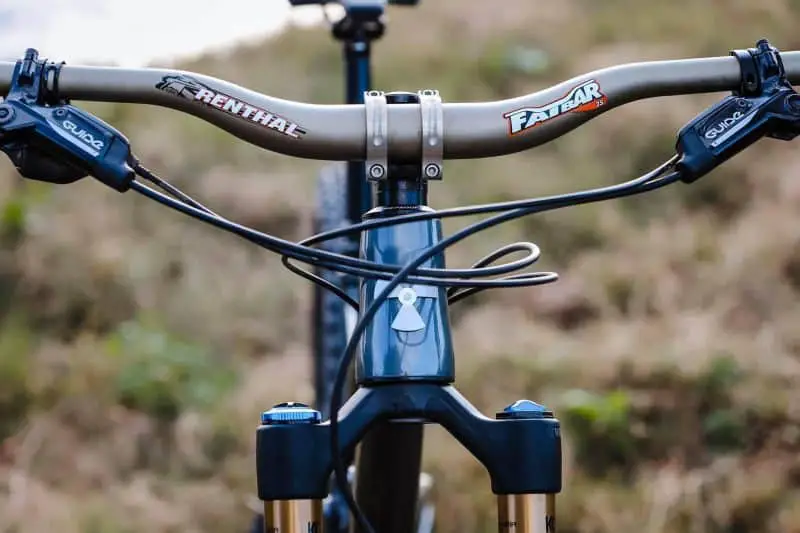Last Updated on March 10, 2022
Handlebars are an important consideration to make when setting up a mountain bike. This is where your control depends on so it needs to fit you well. You should also be comfortable in using the handlebar because it lets you maneuver your bike.
You surely don’t want to have very long handlebars that stretch your arms to the limit. Or maybe get one that’s very short and feels wobbly on the trails!
This is why you need to learn how to measure mountain bike handlebars. This helps you get the right handlebar fit for you so you can ride in the best way possible.
That’s what this article is about.
Because here, we’ll be teaching you how to measure mountain bike handlebars. We’ll also give you insights and tips so you can choose the right one for you.
Common Handlebar Measurements
Handlebars may all look the same for new mountain bikers. But there’s actually a lot of types and sizes out there.
Every mountain bike handlebar has its own geometry. They also have their own measurement that suits a specific mountain bike discipline. This helps riders hit that sweet spot which improves their riding performance.
Diameter
The bar diameter determines the strength and stiffness of your handlebars. Its exact measurement is in the middle of your handlebar. This is also the area where you’ll mount the stem.
The standard handlebar diameter size is 31.8 mm. But bigger 35 mm handlebars are growing in popularity lately. Having a larger clamp area provides a stronger and stiffer handlebar. And most enduro and downhill riders prefer this.
Make sure that your bar and stem have the same diameter, so they’ll fit properly.
Width
The handlebar width is usually what most riders think about when choosing the right size. It’s measured from one end of the bar to the other. Unfortunately, wider bars are the current fad for trail riders even if they’re not the right fit.
Using wider bars has a lot of advantages, though. These increase stability when going downhill and makes breathing easier during climbs. Meanwhile, narrow bars give a higher range of movement for the arms.
The key point of choosing the right handlebar width is to find one that fits your riding style. You also need to consider the terrain you usually ride on. Most mountain bikers prefer bar widths between 740 mm and 800 mm.
Rise
Rise is the height difference between the center of your handlebar and the grip placement area. Choosing the right handlebar rise depends on your bike. You might also need more of it if your bike is too low or too high.
This comes in four types:
- High rise
- Mid rise
- Low rise
- Zero rise
Downhill riders usually choose high rise bars to minimize weight distribution on the front. This makes it easier for them to lift the front wheel. Cross-country riders want more weight at the front. So, they prefer low rise or flat bars to increase traction.
A smart tip, though, is to adjust your spacers to move around your bar height. This way, you don’t have to buy a new handlebar.
Up sweep
Up sweep refers to the vertical angle of the handlebars. This also affects the bar’s rise measurement. Its primary purpose is to provide the rider with a good neutral wrist angle.
This prevents naturally occurring discomforts. It also helps avoid injuries from improper wrist position during a ride.
You’ll usually find handlebars with an up sweep of 4 to 6 degrees. But there are also handlebars with zero or high up sweep used by professional riders.
Back sweep
Back sweep is the way the handlebar bends to the back of the bike. Just like the up sweep, this gives the rider’s wrist a more comfortable position. This helps avoid discomfort and injuries and improves performance.
You’ll usually find handlebars with a back sweep of 0 to 45 degrees.
Measuring the Handlebar

The easiest way to find the correct measurements is to look at the written measurements on your handlebar. But there are cases where you can’t find the measurements because they faded. Or if the handlebar has already been cut down to a specific size.
Just get the measurements yourself if that’s the case. Prepare a tape measure to determine your handlebar’s measurements.
Handlebar diameter
Use a vernier caliper to get the accurate measurement of your bar diameter. Place it in the middle of your handlebar. You can use a tape measure if you don’t have a vernier caliper.
Wrap around the tape measure to the bar. Then see where the tip meets the other side to get the circumference.
Divide the circumference by pi using this formula:
(circumference/𝜋)=diameter
The common handlebar diameters are 22.2 mm, 31.8 mm, and 35 mm.
Handlebar width
Getting the handlebar width is easy. Just place your handlebar width on a flat area. Then use the tape measure to get the length from one end of the bar to the other.
It’s best to remove the grips on your handlebar to get the accurate measurement. Because there are some grips that add a few centimeters, or inches to the exact bar width.
Handlebar height
Getting your handlebar height is more complicated than getting the width. You need to find the midsections of the middle and tip of your handlebar. Use these points to get your handlebar height.
Related: How to Raise Handlebars on a Mountain Bike
Standard Handlebar Widths for Different Disciplines
Each mountain bike discipline has its own preference for choosing handlebars. This is because each has their own unique riding style.
Cross-country riders have narrower handlebars and longer stems. This makes it easier for them to move their body forward. It also helps increase pedal efficiency and makes it easier to conquer the climbs.
Downhill riders want wider bars and shorter stems to increase stability on the descents. This also gives more confidence when riding aggressively. Meanwhile, enduro bikes have measurements somewhere in the middle. This is because enduro is a mix of cross-country and downhill.
It gives them enough control when going downhill. And also puts them in a good pedaling position on the climbs. Balance is important for enduro bikes.
Related: The 10 Best Mountain Bike Handlebar Grips
Body Size and Handlebar Width
Your mountain bike discipline is a large factor when choosing the right handlebar width. But you also need to consider your body size.
Smaller riders have narrower bars because they feel more comfortable and stable. Larger riders also opt for wider bars for the same reason.
Do a regular push up and see where your hands are naturally placed. You can then ask a friend to mark where your hands are. You can then use this as a basis to choose the right handlebar size.
Cutting Your Mountain Bike Handlebars
You can cut your handlebar if they are too wide for you. Cutting off 5 mm to 10 mm of length can make a tremendous difference in your riding.
Most handlebars have increments on each end. This lets you know where you should cut your bars. You can use a hacksaw or a pipe cutter when cutting an alloy or carbon handlebar.
Conclusion
A mountain bike handlebar may look like a simple part of your bike. But there are many complex measurements you need to consider, to make the most out of it.
Learning how to measure mountain bike handlebars helps you get the right size for you. This then helps you achieve optimal riding performance.
Not only does this make you a faster and better mountain biker. But this also makes your rides more comfortable and enjoyable.
Related:
How to Change Handlebar Grips on a Mountain Bike
